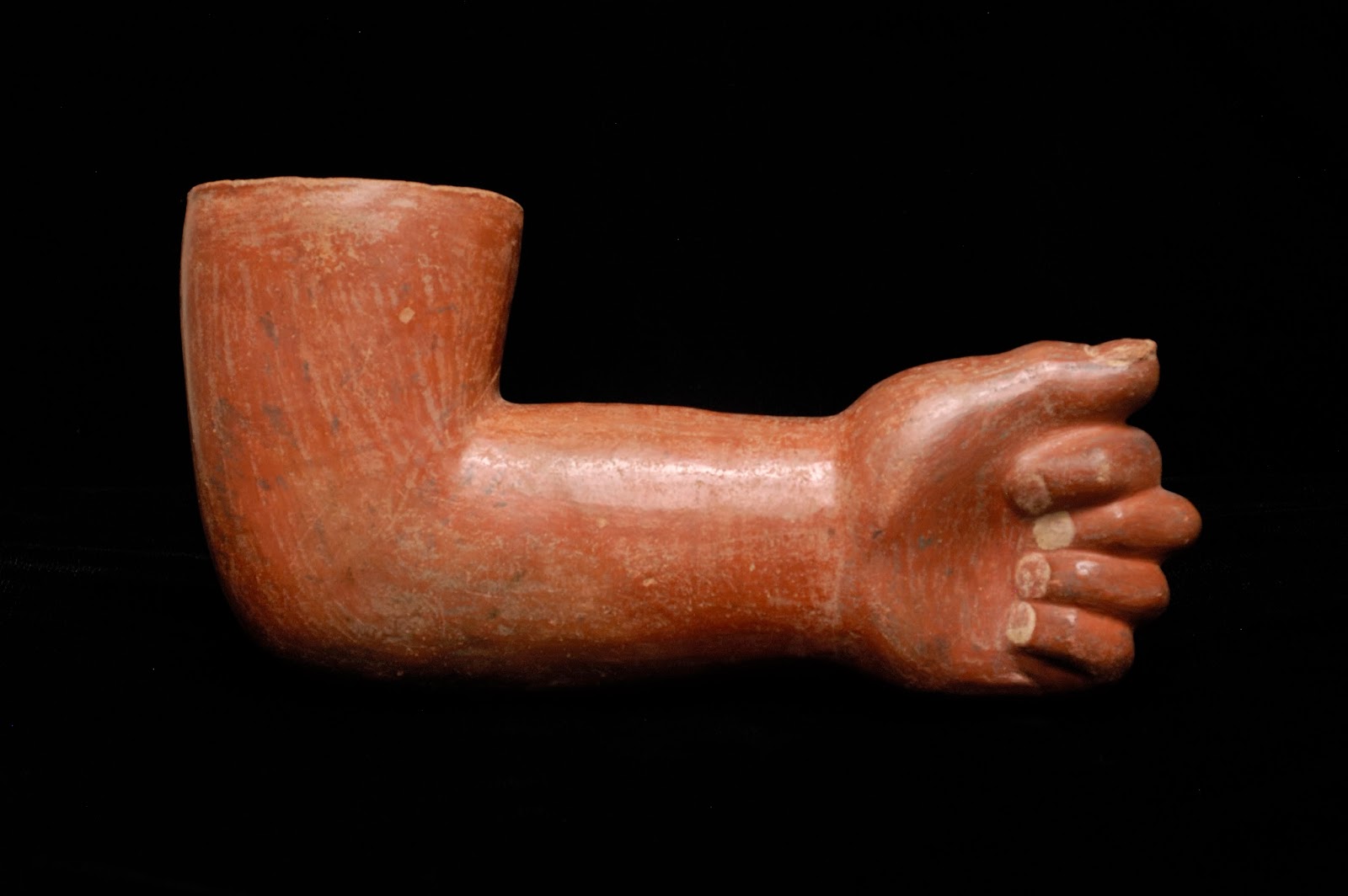PAST EXHIBITION
Between Mountains and Sea: An Interview with Curator Kimberly Jones
OPENS
February 01, 2014
CLOSES
March 01, 2014
SHARE
About the Exhibit
February 2014
This weekend, we opened the much-anticipated exhibition Between Mountains and Sea: Arts of the Ancient Andes. A collaboration with UT’s Department of Art and Art History, the exhibition comprises a special selection of objects that illuminate the lifestyle, technological achievements, and ideology of pre-Inka cultures among the coastal Andes of South America. With 80 extraordinary works from the University’s collections and loans from the Dallas Museum of Art, the presentation features intricately woven textiles, painted ceramic vessels, and modeled effigies. We recently sat down with guest-curator Kimberly Jones to get a behind-the-scenes perspective on this exciting new exhibition.

Early Intermediate Period (200-800 CE),
Vessel of a human forearm, ceramic, slip paints,
Department of Art and Art History, College of Fine Arts,
The University of Texas at Austin
Which work of art in the exhibition is your favorite? Why?
For its remarkable condition and incredible visual artistry, my favorite piece in the exhibition has to be the Paracas Mantle of Birds, which is on loan from the Dallas Museum of Art. The mantle is a magnificent testament to the rich tradition of textiles arts in the Andes, from the past through the present. Regarding the University of Texas collections held by the Department of Art and Art History, there are many great objects on display. The one that I enjoy most is the Moche Ceramic Vessel modeled as a Human Forearm, with the knuckles arranged in a symbolic half-fist gesture. The gesture is specific to Moche ritual practice and may refer to their mountainous settings. The vessel thus exemplifies a playfulness yet faithfulness by Moche artisans to working within a developing symbolic visual system.
Were there any particular challenges in organizing the show?

Early Horizon – Early Intermediate Period (300-100 BCE),
Mantle with condors, camelid fiber, plain-weave,
stem-stitch embroidery, Dallas Museum of Art,
The Eugene and Margaret McDermott Art Fund, Inc.,
in memory of John O’Boyle
The organization of this exhibition came with restrictions in budget and timing, the latter only augmented by my (exciting) jobtransition to the Dallas Museum of Art in Fall 2013. Such circumstances meant limitations to depth and refinements. Nevertheless, the UT collection speaks for itself in the range and quality of Andean arts on exhibit. And the Blanton team was graciously and adeptly attentive to the challenges that came with executing the exhibit within just a few short months. In the end, it has been a great pleasure to work with the Blanton staff, and to highlight UT Austin collections, in particular those held by the Department of Art and Art History, by featuring these exemplary ancient visual arts from the Andes region. The objects, like the remarkable peoples who made them, deserve recognition, appreciation, and care.
Most of the objects featured are 3D; did that play a role in how you came up with the layout or any other aspect of the exhibition?
An audience should have the opportunity to view three-dimensional objects up-close and from various angles, to appreciate them fully. The design was intended, therefore, to provide cases for movement around principal objects. It also varies between singular views of specific objects for their individual visual, technical, and iconographic merit; and object groups that reflect standardized aspects of style or production.

Late Intermediate Period (900 – 1470 CE),
Stirrup spout bottle as sea lion, ceramic,
Department of Art and Art History, College of Fine Arts,
The University of Texas at Austin
What is something that visitors will be surprised to learn about these cultures?
I would tend to presume that popular appreciation of Andean cultures naturally addresses the mountains, as the former divide – or bridge – the tropical forest and coastline. So I would hope that many visitors will find it interesting to consider the delicate position of desert coastal populations situated between the soaring highland peaks and vast ocean, the duality inherent in such a harsh landscape with precarious dependence on these two contrasting resources.
What do you hope that people with take away from this show?
Simply put, I would hope that people will come away from this exhibit with admiration (whether renewed or first-time) for the great diversity of cultures that preceded the Inka (Inca) in the Andean regions and that thrived on the coast of Peru for over 5000 years.
Guest-curator Kimberly Jones is the Assistant Curator of the Arts of the Americas at the Dallas Museum of Art. Prior to that, she served as curator of the Art and Art History collection in the Art and Art History department at the University of Texas at Austin. Between Mountains and Sea: Arts of the Ancient Andes is on view from February 1, 2014 through August 17, 2014. To learn more about the exhibition, click here.

